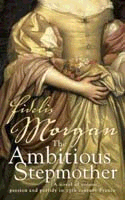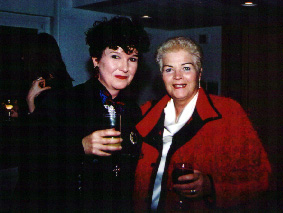|
One critic has described
the Countess and Alpiew as "Cagney and Lacey in corsets".
They"re a far cry from the meek, downtrodden heroines often
associated with historical fiction. Are you cheating by introducing
modern-day attitudes?
|
| |
I get very cross when people write books set in somewhere that is ‘Olde’
rather than giving a true and accurate taste of the time. Jacobean
times (i.e. the early seventeenth century) were black, gruesome and
violent in taste; but by the time I'm writing things have changed.
There are strangely familiar parallels to our own time.
You have had the 1660s where men wore pink satin, purple velvet, lace
cuffs and long hair and women started to talk back; then the 1670s
which were the same, only more so; the 1680s saw the rise of the
merchant classes and people who got into Society by making money; then
in the 1690s disillusion set in, older people looked back fondly on
the 1660s while the youth were more puritanical and looked for
enlightenment in financial success rather than sheer fun.
People also started making huge gains and losses on the newly
invented stock market. I've tried to capture the spirit of the age as
well as I could. I always go to primary sources and the obvious place
to look is the plays of the time and also crime reports and things
like rates books. Crime is crime, and has been much the same since
Cain slew Abel. From the plays and poetry you pick up an obsession
with wit and sex and, a certain robust style. Even the tragedies are
as camp as anything. (I don’t think they'd play too well today as
people would laugh in all the wrong places).
The Restoration drama was so exuberant and lively, and female
characters are really positive. You have wives cheating on husbands
and brokering marriage deals before accepting men's hands. There are
women who are social upstarts, gambling women, sarcastic female roués
and pert maids who talk back to their masters and mistresses. There
are women in all walks of life, businesswomen, landladies, writers,
even female scientists.
I have done my best to capture the feel of this in the books and am
delighted that I show that women had a bold spirit long before the
dour and humourless Suffragettes. By the way, I love the descriptions
I am getting for the Countess series: Tart Noir in petticoats, Columbo
in a powdered wig, Cagney & Lacey in corsets…They manage to
hit exactly the feel I am going for.
|
|
You obviously do a lot of research. Does this mean you spend all
your time in libraries? |
 |
I only ever go to the British Library and then because I need to
consult a long-lost book about some subject I am a stranger to - like
the alchemy in Unnatural Fire, and syphilis and The Passions in The
Rival Queens. For The Ambitious Stepmother I consulted a particular
French recipe book of the period, and read some very bizarre early
French ‘fairy tales’.
I prefer to go to the places I am featuring in the book rather than
read about them. I timed walks round the Covent Garden churchyard in
Unnatural Fire. I walked around York Buildings, the Watergate and the
Tower of London for The Rival Queens and for The Ambitious Stepmother
of course I went to Paris.
When you are on site little things always pop up at you - even if
it's just the weather and the feel of the place. Frequently you also
come upon anecdotal stuff that no one thinks to write about in serious
books but which serves as footnotes in guidebooks.
I was lucky because I've written quite a bit in the past about Marie
Antoinette so I am already very familiar with the layout and spirit of
Versailles, and as a child I spent a few years of school holidays
living in Montmartre with my mother, who was a painter on The Butte,
Montmartre, so I know Paris well.
For The Ambitious Stepmother I ventured to new (to me) corners of
Versailles, specifically The Potager du Roi - the King's kitchen
garden - where I was told about Louis XIV's obsession with green peas.
I also went to Saint-Germain-en-Laye of course. What a gloomy palace
that is, but what a splendid position it occupies. I was lucky. I went
with two friends and had the nicest lunch in Saint-Germain, and the
most glorious supper ever in the restaurant of the Potager at
Versailles, which seemed very fitting to the subject of the book.
|
|
Does the research ever throw up surprising discoveries that
force you to rethink the plot? |
| |
I think the Countess series has a guardian angel in charge of
serendipity. In Unnatural Fire I decided, due to the usual
distribution of free houses by Charles II to his ex-mistresses, to
give the Countess a home in Jermyn Street (spelled German on a map of
the time). I also decided to have a famous cameo role in the book. Of
course the Man of the Millennium, Isaac Newton, was the obvious
choice. It was only when shopping in Jermyn Street that I picked out
which house the Countess must have had. I decided on a certain house,
and the one next door had a Blue Plaque. I put on my glasses to read
it - and wouldn't you know it said 'Isaac Newton lived here' on dates
including 1699.
The same magical thing happened for The Rival Queens. I chose Pepys
and decided to set the book around the York Buildings area, south of
the Strand. I believed that Pepys lived in Clapham at this point, but
it was only after reading a detailed biography I found he was staying
in 1699 at the home of his friend in York Buildings. Sheer
coincidence! It went further, in fact, as the friend was a Chairman of
the East India Company, which has an important role in the story.
I thought the same thing could not happen a third time, but it did. I
couldn't think of a suitable cameo. No one seemed to be famous enough.
I toyed with D'Artagnan, but then discovered that Dumas had cheated a
little and that he was actually dead by this time. And as the book The
Man in The Iron Mask features D'Artagnan, I left the whole subject of
the Masked Man alone. It was only when I was reading an account of
life in the Bastille that I finally read the chapter - the Mysterious
Masked Prisoner. I had been skipping it, thinking it irrelevant. But
it turns out the Man In the Iron Mask was brought up from the South of
France only a few months before I banged the Countess and Alpiew up
inside its fatal walls. So my third guest-artist dropped into the book
of his own accord.
In The Ambitious Stepmother there are also two minor guest
appearances, The Marquis de Béchamel - the man who invented the
sauce - and James Francis Edward Stuart. (At the time of my book he
was eleven years old, but he grew up to be The Old Pretender.)
|
|
Does your background as an actress influence your writing? It
must help with comic timing, but do you ever act out a scene to make
sure it's working? |

Fidelis with fellow actor Pam St Clements |
I can't stop myself. I think my neighbours must think I have a
constant house full of people as I play all the parts aloud, and allow
nothing to go down that I'd refuse to do as an actor playing the role.
It also helps in motivating the characters. I never make someone in a
book do anything with no apparent reason. I also make a point of never
writing a boring character, even in small roles. I like to think that
if it was a film or a play every character would be fun to play.
|
|
Do you have any rituals to get you in the right frame of mind
for writing? |
| |
Starting a book I have to clean my house from top to bottom. Then I
clear my desk of everything. After a while I start using the floor and
have books and notes and pictures in stacks. I then get to the Post-It
stage, where I write everything that must happen on notes and stick
them onto a huge piece of drawing paper and keep moving them about to
see how everything impacts everything else. Towards the end of the
book I become a recluse and rattle away at the computer day and night
writing the denouement and chase sequences in a hot rush. All along
the way I have carrots dangling - I may buy a new CD (music is an
obsession) or treat myself to a meal out when I reach so many words.
|
|
What are you working on at the moment? |
| |
Book Four in the Countess series - Fortune's Slave. The Countess is
back in London and has money to invest. She invests in the Stock
Market and newly founded Bank of England. She also encounters a young
would-be novelist with a bad grudge against Stockbrokers. He goes by
the name Daniel Foe - only later inserting the little De and turning
to writing fiction. In the book I investigate money and all the
attendant occupations, from banking and embezzlement to begging and
burglary. I have just returned from a massive tour of the USA. And at
the end of Fortune's Slave it seems highly probable that the Countess
will be sailing for The New World...
|
| © Harper Collins 2002, reprinted with their
permission |
|
Enjoyed
it so far?
Want to be informed
whenever the
website is updated?
Join SHOTS mailing
list and recieve EXCLUSIVE online material.
It's FREE! |
|
|
|
 |
|